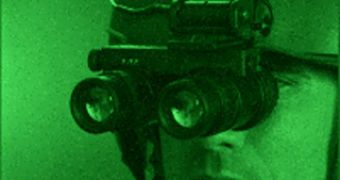Night vision devices primarily work either on image enhancement or thermal imaging techniques. Image enhancement night vision goggles rely on gathering small amounts of light given off by the surrounding medium, such as infrared light for example, which is invisible to the human eyes, then amplifying it in the visible light spectrum, so that the image becomes clear. Thermal imaging, works basically on the same principle, although the night goggles using this technique gather and amplify infrared light in a much lower region of the electromagnetic spectrum, such as that emitted by hot bodies.
Infrared light is a type of electromagnetic radiation with wavelengths much longer than that of visible light. The infrared spectrum is divided into three regions, near-infrared light, which is located beyond the red color of the visible spectrum, the mid-infrared wavelengths, stretching between 1.3 and 3 microns, and thermal-infrared light which has wavelengths between 3 and 30 microns.
Night vision goggles based on image enhancement techniques are normally known as night-vision devices. They rely on an image-intensifier tube to collect, amplify and convert infrared light into visible light. They are mostly famous for producing images in the visible spectrum, bearing an eerie green tint. A simple night vision device consists of a normal lens, an image-intensifier tube and an ocular lens.
How NVDs work
Faint visible light and near-infrared light coming from the surrounding medium are collected by the lens and focused on the image-intensifier tube. The focused light is then converted into a stream of electrons with the help of a photocathode. The electron beam passes through a micro-channel plate which multiplies the number of electrons, thus amplifying the signal. On the other side of the NVD lies a phosphorus coated screen that collects the emitted electrons, and converts them into visible light. The image is always monochromatic and the color is given by the type of the phosphorus used to coat the screen.
Night vision goggles using thermal imaging techniques
These types of night vision devices are somehow more complicated although the basic principle still applies. Thermal infrared light emitted by the medium is collected and focused on a phase array with the help of a lens. The phase array creates a thermogram based on the pattern of light hitting it and then converts it into a series of electrical impulses which are sent to a signal processing unit, having the role of translating that information into data for the display.
Most of these devices are able to produce images with a frame rate of 30 frames per second and can detect variations in temperature between -20 and 2,000 degrees Celsius.
More advanced models make use of cooling systems that keep the sensors at a temperature of roughly zero degrees Celsius, enabling them to produce high resolution images and achieve remarkable sensitivity levels. The applications for night vision devices are practically endless, albeit the most common of them are for military, law enforcement and surveillance and security purposes.

 14 DAY TRIAL //
14 DAY TRIAL //